B0041VYHGW EBOK (62 page)
Authors: David Bordwell,Kristin Thompson

The director can also achieve a strong effect by denying frontality, keeping us in suspense about what a character’s face reveals. At a climactic moment in Kenji Mizoguchi’s
Naniwa Elegy,
some of the cues for emphasis are reversed
(
4.159
,
4.160
).
We get a long shot rather than a closer view, and the character is turned from us and moving away from the camera, through patches of darkness. Ayako is confessing to her suitor that she’s been another man’s mistress. Her withdrawal conveys a powerful sense of shame, and we, like her friend, have to judge her sincerity based on her posture and voice. In this and our other examples, several techniques of mise-en-scene dovetail from moment to moment in order to engage us more vividly with the action.
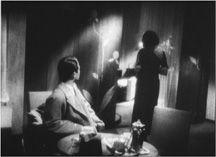
4.159 At the height of the drama in
Naniwa Elegy,
Kenji Mizoguchi has the heroine move away from us, into depth …
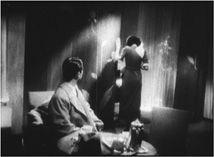
4.160 … and as she passes through patches of distant darkness, our curiosity about her emotional state intensifies.
Our Hospitality
Our Hospitality,
like most of Buster Keaton’s films, exemplifies how mise-en-scene can economically advance the narrative and create a pattern of motifs. Since the film is a comedy, the mise-en-scene also creates gags.
Our Hospitality,
then, exemplifies what we will find in our study of every film technique: An individual element almost always has
several
functions, not just one.
Consider, for example, how the settings function within the plot of
Our Hospitality.
For one thing, they help divide the film into scenes and to contrast those scenes. The film begins with a prologue showing how the feud between the McKays and the Canfields results in the deaths of the young Canfield and the husband of the McKay family. We are left in suspense about the fate of the baby, Willie. Willie’s mother flees with her son from their southern home to the North (action narrated to us mainly by an intertitle).
“The most striking aspect of the Keaton pictures was the enormous amount of trouble lavished over every gag. Production value on such a scale requires more than a simple desire to make people laugh. It is not surprising that Keaton’s childhood aim was to be a civil engineer.”
— Kevin Brownlow, film historian
The plot jumps ahead many years to begin the main action, with the grown-up Willie living in New York. There are a number of gags concerning early-19th-century life in the metropolis, contrasting sharply with the prologue scene. We are led to wonder how this locale will relate to the southern scenes. Soon Willie receives word that he has inherited his parents’ home in the South. A series of amusing short scenes follows as he takes a primitive train back to his birthplace. During these scenes, Keaton uses real locales, but by laying out the railroad tracks in different ways, he exploits the landscapes for surprising and unusual comic effects, which we shall examine shortly.
The rest of the film deals with Willie’s movements in and around the southern town. On the day of his arrival, he wanders around and gets into a number of comic situations. That night he stays in the Canfield house itself. An extended chase occurs the next day, moving through the countryside and back to the Canfield house for the settling of the feud. Thus the action depends heavily on shifts of setting that establish Willie’s two journeys, as baby and as man, and later his wanderings to escape his enemies’ pursuit. The narration is relatively unrestricted after Willie reaches the South, shifting between him and members of the Canfield family. We usually know more about where they are than Willie does, and the narrative generates suspense by showing them coming toward the places where Willie is hiding.
Specific settings fulfill distinct narrative functions. The McKay estate, which Willie envisions as a mansion, turns out to be a tumbledown shack. The McKay house is contrasted with the Canfield’s palatial plantation home. In narrative terms, the Canfield home gains even more functional importance when the Canfield father forbids his sons to kill Willie on the premises: “Our code of honor forbids us to shoot him while he is a guest in our house.” (Once Willie overhears this, he determines
never
to leave.) Ironically, the home of Willie’s enemies becomes the only safe spot in town, and many scenes are organized around the Canfield brothers’ attempts to lure Willie outside. At the end of the film, another setting takes on significance: the landscape of meadows, mountains, riverbanks, rapids, and waterfalls across which the Canfields pursue Willie. Finally, the feud ends back in the Canfield house itself, with Willie now welcomed as the daughter’s husband. The pattern of development is clear: from the opening shootout at the McKay house that breaks up Willie’s family to the final scene in the Canfield house with Willie becoming part of a new family. In such ways, every setting becomes highly motivated by the narrative’s system of causes and effects, parallels and contrasts, and overall development.
The same narrative motivation marks the film’s use of costume. Willie is characterized as a city boy through his dandified suit, but the southern gentility of the elder Canfield is represented through his white planter’s suit. Props become important here: Willie’s suitcase and umbrella succinctly summarize his role as visitor and wanderer, and the Canfields’ ever-present pistols remind us of their goal of continuing the feud. In addition, a change of costume (Willie’s disguising himself as a woman) enables him to escape from the Canfield household. At the end, when the characters put aside their guns, the feud is over.
Like setting, lighting in
Our Hospitality
has both general and specific functions. The film alternates scenes in darkness with scenes in daylight. The feuding in the prologue takes place at night; Willie’s trip South and wanderings through the town occur in daylight; that night Willie comes to dinner at the Canfield’s and stays as a guest; the next day, the Canfields pursue him; and the film ends that night with the marriage of Willie and the Canfield daughter. More specifically, the bulk of the film is evenly lit in the three-point method. Yet the somber action of the prologue takes place in hard sidelighting
(
4.161
,
4.162
).
Later, the murder scene is played out in flashes of light—lightning, gunfire—that fitfully punctuate the overall darkness. Because this sporadic lighting hides part of the action from us, it helps build suspense. The gunshots themselves are seen only as flashes in the darkness, and we must wait to learn the outcome—the deaths of both opponents—until the next flash of lightning.
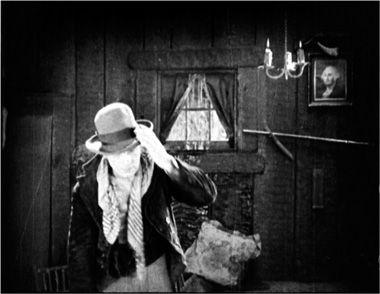
4.161 In
Our Hospitality,
when the elder McKay flings off his hat to douse the lamp, the illumination changes from a soft blend of key, fill, and backlight …

4.162 … to a stark key light from the fireplace.
Most economically of all, virtually every bit of the acting functions to support and advance the cause–effect chain of the narrative. The way Canfield sips and savors his mint julep establishes his southern ways; his southern hospitality in turn will not allow him to shoot a guest in his house. Similarly, Willie’s every move expresses his diffidence or resourcefulness.
Even more concise is the way the film uses staging in depth to present two narrative events simultaneously. While the engineer drives the locomotive, the other cars pass him on a parallel track
(
4.163
).
In other shots, Willie’s awareness or ignorance of a situation is displayed through planes of depth
(
4.164
,
4.165
).
Thanks to such spatial arrangements, Keaton is able to pack together two story events, resulting in a tight narrative construction and in a relatively unrestricted narration. In
4.164
, we know what Willie knows, and we expect that he will probably flee now that he understands the sons’ plans. But in
4.165
, we are aware, as Willie is not, that danger lurks around the corner; suspense results, as we wonder whether the Canfield boys’ ambush will succeed.
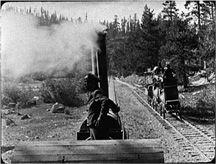
4.163 Within the same frame, we see both cause—the engineer’s cheerful ignorance, made visible by frontality—and effect—the runaway cars.
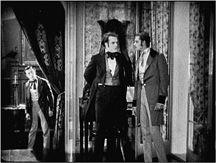
4.164 The Canfield boys in the foreground make plans to shoot Willie, who overhears them in the background.
